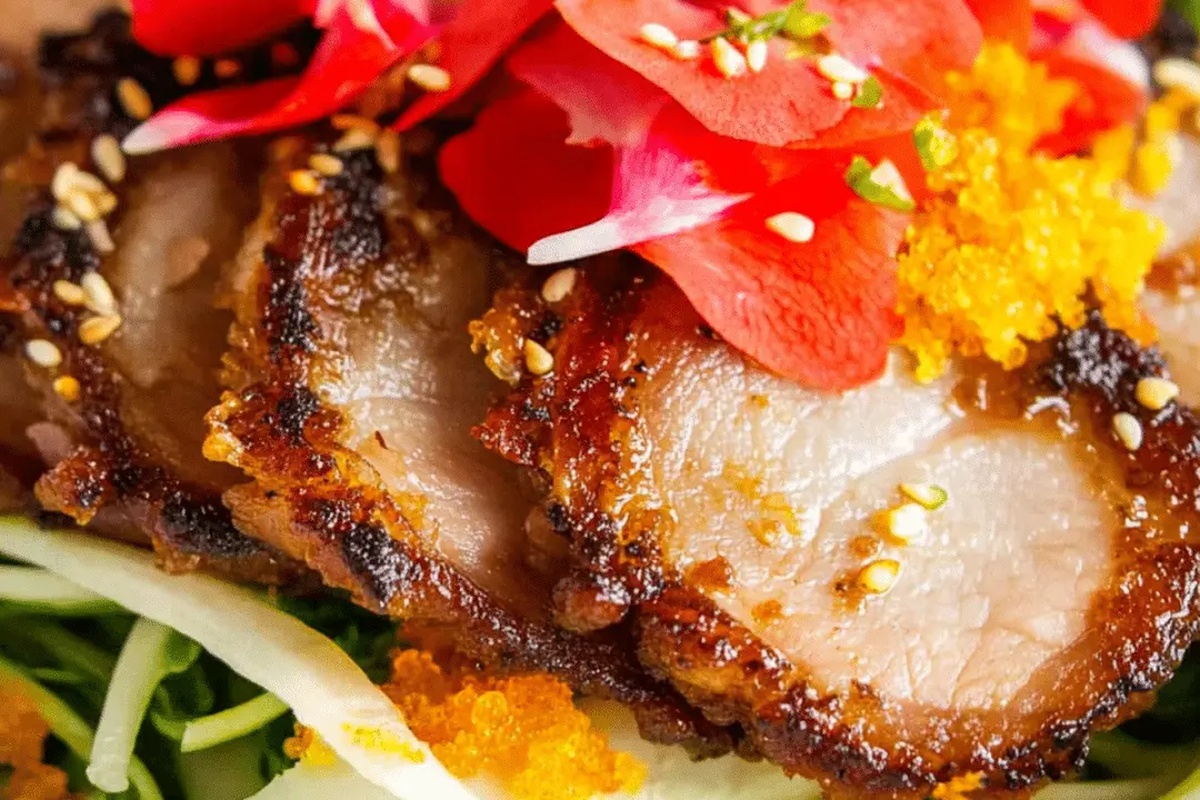Korean Pork Belly with Sumi Salad Recipe
Crispy Korean pork belly has been my obsession since discovering its incredible flavor profile during a memorable trip.
Wandering through bustling street markets, I encountered vendors crafting this delectable dish with precision and passion.
Each slice promised a perfect balance of tender meat and crackling skin.
Meat lovers understand the magic of slow-cooked pork that melts effortlessly on the tongue.
Marinades infused with soy, garlic, and ginger create depth that makes this recipe irresistible.
Salt, spice, and umami dance together in a symphony of taste.
You’ll want to bookmark this recipe and impress everyone at your next gathering.
Korean Pork Belly With Sumi Salad That’s Full of Contrast
Korean Pork Belly & Sumi Salad Ingredients
Main Protein:Marinade Ingredients:Salad Components:Seasoning and Aromatics:Korean Pork Belly with Sumi Salad Method
Step 1: Prepare Pork Belly Marinade
Mix together soy sauce, brown sugar, minced garlic, grated ginger, sesame oil, and rice wine in a large bowl.
Submerge the pork belly completely in the marinade, ensuring each piece is well coated.
Cover and refrigerate for at least 2 hours, or ideally overnight, to allow the flavors to deeply penetrate the meat.
Step 2: Preheat Cooking Surface
Heat a cast-iron skillet or grill pan over medium-high heat.
If using an outdoor grill, prepare it for direct high-heat cooking.
The cooking surface should be hot enough to create a beautiful caramelized exterior on the pork belly.
Step 3: Sear Marinated Pork Belly
Remove pork belly from the marinade and pat dry with paper towels.
Place the meat on the hot cooking surface, allowing each side to develop a rich, golden-brown crust.
This process should take about 3-4 minutes per side, creating a delicious crispy exterior.
Step 4: Create Sumi Salad Base
While the pork is cooking, prepare the salad base:Step 5: Whisk Sumi Salad Dressing
In a small bowl, combine:Whisk ingredients until well blended and slightly emulsified.
Step 6: Slice and Plate Pork Belly
Once pork belly is cooked to desired doneness, let it rest for 5 minutes.
Slice against the grain into thin, bite-sized pieces.
Arrange the salad greens on a platter and top with the sliced pork belly.
Step 7: Finish and Serve
Drizzle the prepared Sumi salad dressing over the pork and greens.
Sprinkle with toasted sesame seeds and additional chopped green onions for extra flavor and visual appeal.
Serve immediately while the pork is still warm.
Sumi Salad Pairing Tips with Korean Pork Belly
Pork Belly and Sumi Salad Leftovers
What to Serve With Korean Pork Belly
Pork Belly Salad With Korean-Inspired Combos
FAQs
Gochujang (Korean red chili paste), soy sauce, garlic, and brown sugar create the bold, sweet-spicy-umami marinade that makes Korean pork belly so delicious.
While tasty, pork belly is high in fat and calories, so it’s best enjoyed in moderation as part of a balanced diet. Pairing it with a light vegetable salad helps create a more nutritionally balanced meal.
Thin slicing ensures even cooking, helps the marinade penetrate the meat, and creates a more tender texture that’s easier to eat and more appealing visually.
If gochujang is unavailable, you can use sriracha or chili garlic sauce mixed with a bit of miso or tomato paste to approximate its complex flavor profile, though the taste won’t be exactly the same.
Print
Korean Pork Belly with Sumi Salad Recipe
- Total Time: 30 minutes
- Yield: 4 1x
Description
Sizzling Korean pork belly dances with tangy sumi salad, creating a symphony of bold flavors that transport diners straight to Seoul’s bustling streets. Crisp, caramelized meat paired with zesty greens promises a delightful culinary journey you won’t soon forget.
Ingredients
Protein:
- 1.5 lbs (680g) skinless pork belly, thickly sliced
Marinade and Seasonings:
- 2 tablespoons soy sauce
- 1 tablespoon gochujang (Korean chili paste)
- 2 cloves garlic, minced
- 1 teaspoon grated ginger
- 1 teaspoon sesame oil
- Salt and pepper, to taste
Sumi Salad and Garnish:
- 3 cups cabbage, finely shredded
- 1 tablespoon rice vinegar
- 1 teaspoon sesame oil
- 1 teaspoon honey
- 1 teaspoon lemon juice
- 1 teaspoon sesame seeds
- 1 green onion, thinly sliced
- Lettuce leaves
- Ssamjang (Korean dipping sauce) or soy sauce with vinegar
- Steamed rice (optional)
Instructions
- Whisk together gochujang, soy sauce, rice vinegar, honey, and sesame oil in a non-reactive bowl, creating a vibrant and glossy marinade.
- Place pork belly slices into the marinade, ensuring each piece is thoroughly coated, then refrigerate for at least 2 hours or overnight for deeper flavor penetration.
- Remove marinated pork from refrigerator 30 minutes before cooking to allow meat to reach room temperature, promoting even cooking.
- Preheat grill or heavy-bottomed skillet to medium-high heat, preparing for a caramelized exterior on the pork.
- Arrange marinated pork belly slices on the hot cooking surface, allowing each side to sear and develop a rich, mahogany-colored crust, approximately 3-4 minutes per side.
- While pork cooks, prepare the sumi salad by thinly slicing cucumber, radishes, and green onions into delicate, translucent pieces.
- Combine salad vegetables in a bowl, drizzling with rice vinegar, sesame oil, and a sprinkle of toasted sesame seeds for added texture and nutty flavor.
- Once pork belly reaches desired doneness with crispy edges and succulent interior, remove from heat and let rest for 3-5 minutes.
- Slice pork belly against the grain into bite-sized strips, revealing the tender meat’s layered texture.
- Plate the caramelized pork belly alongside the fresh, crisp sumi salad, garnishing with additional sesame seeds and chopped green onions for a vibrant presentation.
Notes
- Slice pork belly thinly against the grain for maximum tenderness and faster marinating.
- Use a mix of gochujang and soy sauce to create a deep, complex flavor profile that penetrates the meat.
- Pat the pork belly dry before marinating to help the sauce cling better and achieve a beautiful caramelization.
- Allow at least 30 minutes of marinating time, but overnight marination will intensify the flavors dramatically.
- Prep Time: 15 minutes
- Cook Time: 15 minutes
- Category: Dinner
- Method: Roasting
- Cuisine: Korean
Nutrition
- Serving Size: 4
- Calories: 360
- Sugar: 4g
- Sodium: 560mg
- Fat: 22g
- Saturated Fat: 8g
- Unsaturated Fat: 12g
- Trans Fat: 0g
- Carbohydrates: 16g
- Fiber: 3g
- Protein: 24g
- Cholesterol: 80mg




Katherine Pierce
Recipe Curator & Food Educator
Expertise
Education
Boston University Metropolitan College
Certificate Program in the Culinary Arts
Focus: French and international cuisine techniques, Hands-on culinary training with industry professionals, Food industry insights and operations
Katherine grew up believing every dish has a story. She studied the art of food at Boston University and explored the history behind it. She loves pulling easy recipes from every corner of the world and putting them at your fingertips.
When Katherine’s not writing or testing new flavors, she’s teaching cooking classes, baking colorful mooncakes, or dreaming up new ways to mix old favorites with new twists.